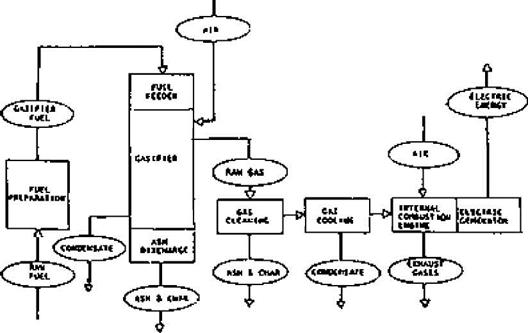 Chapter 2 — Small wood and charcoal gasifiers for operation. of internal combustion engines
Chapter 2 — Small wood and charcoal gasifiers for operation. of internal combustion engines
The gasification of coal and carbon containing fuels and the use of the gas as fuel in internal combustion engines is a technology which has been utilized for more than a century.
There has recently been renewed interest in this technology, mainly as a means to utilize biomass fuels instead of imported petroleum fuels in-developing countries. This interest derives from the documented evidence that, during the Second World War, more than a million vehicles buses, trucks, motorcars, boats and trains — were powered by gasifiers fuelled by wood, charcoal, peat or coal. After the war, nevertheless, there was a complete reversion to liquid fuels as soon as these again became available, obviously because of their convenience, reliability and economic advantages.
Therefore, the impact of biomass gasification on the energy supply systems of developing countries seems to hinge on the answer to one central question: has modern technology and gasifier development led to improved gasifier designs and gasification systems, that can work reliably, efficiently, economically and at a suitable technical level where special skills may be lacking?
In order to answer this question it is necessary to review a number of aspects of the gasification technology. The type of system considered is schematically illustrated in Figure 2.1.
The internal combustion engine uses as fuel gas generated by gasification of vegetable matter with-air. The gas is cleaned and cooled before entering the engine. In Fig. 2.1 the engine is shown driving an electric generator, but it may of course be utilized for any other purpose where such engines are employed.
The possibilities of using different types of engines with producer gas, and the quality of gas needed, will first be reviewed in order to provide the necessary background for an understanding of the effects on gasifier system design.
The theory of gasification, different type of gasifiers and gasified fuels will then be discussed and design guidelines for down-draught gasifiers will be presented. Techniques of gas cleaning and cooling will then be examined. The chapter concludes with a discussion of possible applications, and the hazards and environmental consequences associated with this technology.
From the treatment of these subjects it will become clear that severe constraints still exist to the introduction of gasification systems. However, it will be shown that, within the current state-of-the-art of gasification technology, several technically and economically sound possibilities exist.
In order to assist users and designers of gasification equipment, examples of the power output of an internal combustion engine fuelled by producer gas are given in Appendix I; and the design of a simple downdraught gasification unit, fuelled by wood blocks, is presented in Appendix II.
|
Figure 2.1 Scheme of a producer gas power plant
|
